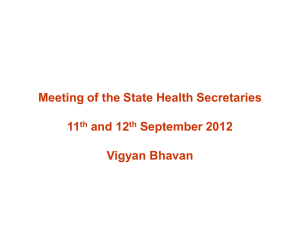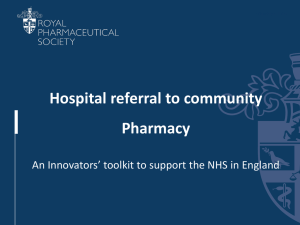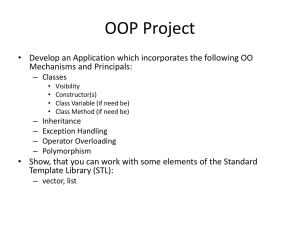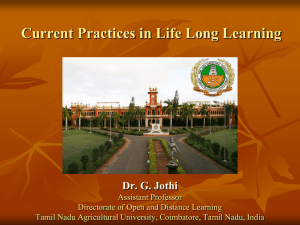Access to Medicines
advertisement
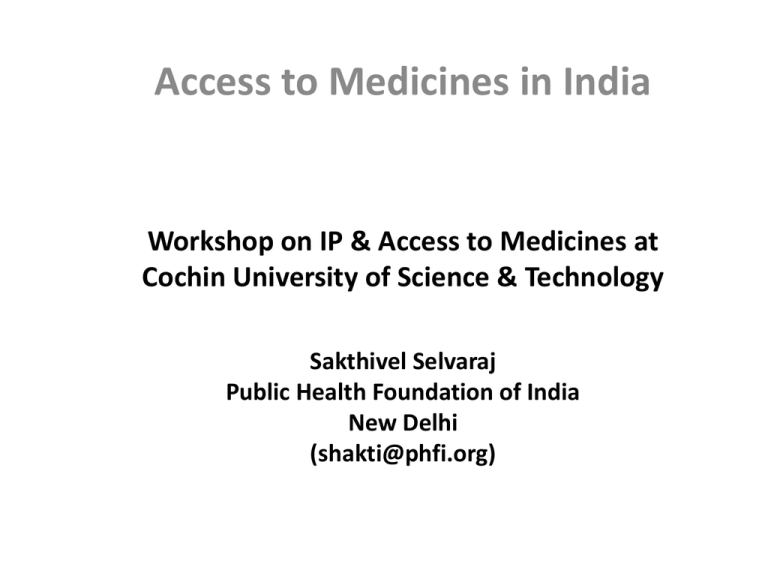
Access to Medicines in India Workshop on IP & Access to Medicines at Cochin University of Science & Technology Sakthivel Selvaraj Public Health Foundation of India New Delhi (shakti@phfi.org) Key Barriers to Access to Medicines Unfair health financing mechanisms; Unreliable supply systems; Unaffordable pricing; Irrational use of medicines; Inadequate funding for research in neglected diseases; Stringent product patent regime. Source of Health Spending Source: National Health Accounts, 2004-05, GoI, 2009 Share of Households’ OOP Expenditure by Quintile Groups, 2009-10 Sector Poorest 2nd Poorest Middle 2nd Richest Richest All (As Percentage of Household Expenditure) OOP Exp. 3.74 4.57 5.11 5.84 7.23 (As Percentage of OOP Expenditure) 5.73 26.41 30.69 32.25 34.35 33.81 (As Percentage of OOP Expenditure) 32.74 73.59 69.31 67.75 65.65 66.19 (As Percentage of OOP Expenditure) 67.26 75.42 72.34 68.28 Inpatient Exp. Outpatient Exp. Drug Exp. Source: Unit Level Records of NSSO. 70.11 66.81 65.90 Percentage of Households Facing Catastrophic Expenditure on Health, 2009-10 (>10% of HH Spend) Quintile Groups Poorest 2nd Poorest Middle 2nd Richest Richest All OOP Expenditure Inpatient Expenditure Outpatient Expenditure Drug Expenditure 7.656 1.082 6.329 4.523 9.875 1.980 7.394 6.012 12.237 2.770 8.848 7.392 16.197 4.496 10.979 9.591 22.456 7.954 16.207 14.852 13.684 3.656 9.951 8.474 Source: Unit Level Records of NSSO. Impoverishment Due to OOP Payments in India (In Millions) Source: Selvaraj and Karan (2009) Government Expenditure on Drugs (%) States 2008-09 (Actuals) 2009-10 (RE) 2010-11 (BE) Assam 5.7 5.6 5.0 Bihar 6.3 5.9 7.0 Gujarat 6.5 4.9 7.6 Haryana 8.6 6.8 5.5 Kerala 10.6 10.4 12.5 Maharashtra 9.6 5.2 5.2 Madhya Pradesh Punjab 9.1 1.1 10.1 1.0 9.3 1.0 Rajasthan 3.0 1.9 1.5 Uttar Pradesh 6.9 4.8 5.3 Jharkhand 2.9 2.3 3.4 West Bengal 9.2 6.8 6.8 Andhra Pradesh 7.3 6.8 10.0 Karnataka 8.0 7.2 6.3 Tamil Nadu Himachal Pradesh 11.2 4.5 9.3 2.3 12.2 1.9 J&K 6.5 5.2 4.3 State-wise Health Insurance Coverage in 2010 25% National Covergae 5% Private Health Insurance Other States and UTs 12% 17% West Bengal 15% Uttrakhand 11% Uttar Pradesh 62% Tamil Nadu 3% Rajasthan 12% Punjab 6% Orissa 12% Maharashtra 2% State Madhya Pradesh 7% Kerala 17% Karnataka Jharkhand 16% 20% Himachal Pradesh 17% Haryana 29% Goa 17% Gujarat 27% Delhi 18% Chattisgarh 15% Bihar 3% Assam 87% Andhra Pradesh 0% 10% 20% 30% 40% 50% 60% Percentage of population covered by Health Insurance 70% 80% 90% 100% State-wise Availability of Free/Partly Free Medicines at Government Facilities during 2004 Bihar Jharkhand Uttrakhand Uttar Pradesh Punjab Haryana Rajasthan Chhatisgarh Goa West Bengal Maharashtra Madhya Pradesh Odisha Assam Himachal Pradesh Andhra Pradesh Gujarat J&K Kerala Karnataka Delhi Tamil Nadu 0 5 10 15 20 Percentage Availability of Free/Partly Free Drugs in Public Health Faciliites (Outpatient Care) Source: Morbidity & Health Survey, NSS, 2004 25 A Comparative Scenario of Drug Availability in TN and Bihar Stock-Outs at Facilities: Bihar vs Tamil Nadu (% Stock-Outs) Drugs Stock Out (%) 100.0 Sakra Manigachi 66.7 33.3 0.0 Bihar Tamil_Nadu Drugs Stock Out at Health Facilities (%)-Bihar Vs Tamil Nadu Trends in All-Commodity and Pharmaceutical Price Index Drug Price Control DPCO-1979 DPCO-1987 DPCO-1995 1. No. of drugs under DPCO 347 142 76 2. No. of Drug categories 4 2 1 Items DPCO under 3. MAPE % allowed on normative/national ex-factory costs to meet postmanufacturing expenses and to provide for margin to the manufacturers 3.1. Category I 40 % 75 % 100 % 3.2. Category II 55 % 100 % N.A. 3.3. Category III 100 % N.A. N.A. 3.4. Category IV 60 % N.A. N.A. 4. % Covered under DPCO 90 % 70 % 20-25 % Distribution Network & Mark-Up in Indian Pharma Market Source: IMS-ORG, 2004 Unaffordable Drug Price - Retail & Procurement Price National Pharmaceutical Pricing Policy, 2012 Key Features: • • • • • • • All 348 NLEM ; Market Based Pricing; Only Formulations; WPI-linked increase; Only single ingredient medicines; Only NLEM dosages & strengths; Patented Medicines not covered. Market Leaders are Price Leaders Market Leaders are Price Leaders Market Share for FDCs Involving Essential Medicines Market Share of Drugs Involving Dosages of EML vis-à-vis Non EML dosages Continuing Trend of Profiteering in India’s Pharmaceutical Sector Implications of NPPP, 2012 Pharma market is unique because: • Market Leader is the Price Leader - When competition exists, leading market players are expected to reduce prices substantially & yet obtain normal profits. • Indian pharma industry behaves abnormally. • Under a therapeutic category, hundreds of players slug it out in the Indian pharmaceutical sector, but with substantial variation in prices. • The prices of leading players very often tend to be the highest, because of aggressive promotional campaigns. • High margins provided by industry to stockiest & retailers encourage them to promote high priced medicines; • Given information asymmetry that creates supplier-induced demand, pharma makers have an upper hand in pushing through medicines that are high priced. Implications of NPPP, 2012 • MBP legitimizes trend of high prices; • Likely to induce players in lower priced segment to drive up prices to closer to highest priced medicines; • Exempts essential medicines - weighted average price of less than or equal to Rs. 3 - would increase in prices of essential medicines (including anti-histaminics, antiasthmatics, some anti-diabetics, anti-hypertensive etc.). • Prices of APIs which are only manufactured by a limited no. of suppliers in India or internationally should be monitored to ensure that a cartel does not emerge that would drive prices up. • WPI-linked price rise; • Price controls & profitability; • Negotiation on patented medicine prices; • Unethical to use proprietary data for public policy; Irrational Medicine Use in India Product Rank 1 2 Product Sales (in Crore Rs.) 135.88 124.31 Market Share 0.497 0.455 Product Description 95.85 92.48 0.351 0.338 Useless liver drug Irrational vitamin combination Blood tonic Irrational analgesic combination Needless antacid Irrational vitamin combination Needless antacid Oral ginseng tonic 5 7 COREX PHENSEDYL COUGH LIV-52 BECOSULES 17 18 DEXORANGE COMBIFLAM 77.04 76.03 0.282 0.278 27 35 DIGENE POLYBION 63.49 54.24 0.232 0.198 38 40 GELUSIL-MPS REVITAL 53.25 53.09 0.195 0.194 Source: IMS-ORG, 2006 Irrational cough mixture Irrational cough mixture Irrational Prescription in Public Health Facilities Bihar (%) Tamil Nadu (%) Average number of drugs per encounter 2.6 3.1 Percentage of drugs prescribed by generic name Percentage of drugs prescribed from essential drug list 73.5 88.0 66.8 88.0 Percentage of encounters with an antibiotic prescribed Percentage of encounters with an injection prescribed Percentage of fixed dose combinations versus single agents 66.0 59.6 4.9 1.4 6.9 0.0 Percentage of encounters with a syrup prescribed 26.2 2.6 HLEG Recommendations • Scale Up Public Spending on Drugs (0.4% GDP): – Expected to reduce OOP; • Strengthen Public Procurement System: – Supply quality generic drugs and enforce rational use; – Centralised Procurement & Decentralised Distribution System; – Warehouses at every district level; – Retail outlets can be set up (or contracted-in) atleast one at every block level and 4-5 at district headquarters. – Drug supply to such stores linked to centralized procurement at state level, so that drugs are of equal quality & costs are minimized by removing intermediaries. Key Characteristics of an Efficient & Reliable Procurement & Distribution System – Atleast 15% of public funds; – Procure EDL medicines (National and state level EDL at three levels; periodic revisions); – Traditional medicines list; – Prescription and Dispensing through STGs; – A two-bid open transparent tendering process; – A 2 passbook system; – Warehouses at every district level; – An Empanelled laboratories for drug quality testing; – Enactment of Transparency in Tender Act; – Prompt Payments; – Prescription audits & social audits; Drugs and Vaccine Security • Revive Drug PSUs by infusing capital with autonomous status; • PSUs will offer opportunity to produce volume drugs & help in 'benchmarking' drug costs; • Revisit FDI rules to bring down share of foreign players to less than 49%. • Co-opt medium & small scale drug industry to produce quality generic medicines for UHS by helping them to transit to GMP-complaint status. • Revive old vaccine mfg. units with additional infusion of capital and new vaccine park with autonomous status. Drug Price Caps • A pervasive price control on all essential drugs is called for; • Price decontrolled drugs to be monitored continuously; • State and Central Cell for price control of drugs; • Price of all new patented drugs to be brought under DPCO automatically; • Weed out irrational drugs: hazardous, irrational, non-essential drugs from mkt; Drug Quality Control • Strengthen Central and State Drug Control Dept., for effective quality control with adequate human resource, technology & institutions; • Regular/periodic monitoring/study of drug production and distribution for quality – blacklisting offenders; • Build a network of drug quality testing laboratories, to be accredited by NABL in each state with periodic renewal; Product Patents • Restrict patenting of insignificant or minor improvements of known medicines (under section 3[d]); • Make use of CL provision under TRIPS; • Data exclusivity clause proposed by EU as part of Indo-EU trade pact needs to be removed to avoid ‘ever-greening’; • Invest in neglected disease R&D by opensource drug development model. Expected Outcomes Expected Outcomes: – Reduction in OOP (reverse ratio – OOP:Govt); – Cost Savings; – Rationality of care ensured; – Quality Generics prescribed & dispensed; – Acute shortages & chronic stock-outs eliminated. Time-Frame: - 1 year (Public Procurement & Public Distribution); - 3-5 years (Public Procurement & Private Distribution. Scaling Up To Achieve Universal Access to Medicines

